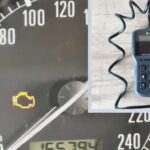In today’s connected world, understanding your car’s health is easier than ever, thanks to the power of Obd2 Apps. These innovative applications transform your smartphone into a sophisticated diagnostic tool, giving you real-time insights into your vehicle’s performance and potential issues. But with so many options available, how do you choose the best obd2 app to suit your needs?
Choosing the right obd2 app can feel overwhelming, but focusing on key features will help you narrow down the options and find the perfect digital mechanic for your pocket. Here’s what to look for in a top-tier obd2 app:
One of the most compelling features of a quality obd2 app is its ability to display real-time data. Imagine having a customizable dashboard right on your phone, showing you everything from engine temperature and RPM to speed and fuel efficiency. This level of immediate feedback, often presented in intuitive gauges and charts, empowers you to monitor your car’s vital signs as you drive.
Beyond just monitoring, a powerful obd2 app acts as your personal diagnostic assistant. It can read and interpret OBD2 fault codes, the standardized codes your car’s computer uses to signal problems. No more guessing what that check engine light means! A good app will not only display the code but also provide a description from an extensive DTC code database, helping you understand the issue and decide on the next steps, potentially saving you a trip to the mechanic for simple issues. Furthermore, advanced obd2 apps offer freeze frame data, capturing sensor readings at the moment a fault code was triggered, providing valuable context for diagnosis.
For car enthusiasts and those focused on vehicle performance, the best obd2 apps offer more than just diagnostics. They can become performance meters, accurately measuring acceleration, horsepower, and other metrics. Some apps even tap into advanced Mode 06 data, revealing ECU self-monitoring test results, which can be crucial for proactive maintenance and preventing costly repairs down the line. Features like emission readiness checks are also invaluable, ensuring your vehicle is compliant with local regulations.
Compatibility is paramount when selecting an obd2 app. The OBD2 standard is widely adopted across vehicles manufactured after 2000, and often even earlier (from 1996 onwards). However, the depth of data accessible can vary between car makes and models. Leading obd2 apps often include specific connection profiles optimized for various manufacturers like Toyota, GM, BMW, and many others, unlocking enhanced features and more comprehensive data access. Before choosing an app, verify its compatibility with your car’s make and model to ensure a seamless experience.
To utilize the capabilities of an obd2 app, you’ll need an OBD2 adapter that plugs into your car’s diagnostic port. These adapters communicate wirelessly with your smartphone via Bluetooth or Wi-Fi. While numerous adapters are available, it’s crucial to choose a reliable one. While budget-friendly options exist, be wary of overly cheap clones, especially those marked as v2.1, as they can be unreliable and even cause connection issues or unstable engine behavior. Reputable brands like Kiwi 3, Viecar, and Veepeak are often recommended for their consistent performance and reliable connection. Investing in a quality adapter ensures a smooth and trustworthy connection between your car and your obd2 app.
In conclusion, an obd2 app is an indispensable tool for modern car owners. Whether you’re a seasoned mechanic or simply want to stay informed about your vehicle’s condition, the right app, paired with a reliable OBD2 adapter, empowers you with knowledge, saves you money, and keeps you confidently in the driver’s seat of your car’s health. Explore the features, ensure compatibility, and unlock the secrets your car has been waiting to share through the power of an obd2 app.
